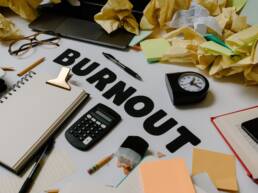Burnout Makes a Resurgence in a Significant Manner – Let's Explore the Reasons

IT’S the fiftieth anniversary of “burnout” entering the corporate lexicon when Herbert Freudenberger, a New York psychologist, first identified it.
I wish I could tell you that we’ve banished it, but instead burnout is back with a vengeance.
Recent data from Deloitte and the research firm Workplace Intelligence cites about half of workers saying they are either exhausted or stressed, and 60 per cent of employees say that they would consider changing jobs to find better well-being provisions.
The working assumption that current corporate wellness programmes are sufficient for the times is being severely tested. Here’s why.
First and foremost, never underestimate the power of the toxic workplace. It’s no accident that the most streamed show in the US during Covid-19 in 2020 was The Office, which satirised the daily grind.
I’ve written here before about the need to address what can be done to combat stress in the workplace itself. Susie Orbach, psychoanalyst and social critic, told me: “Work is where we live and where we hope to have our need for connection, contribution, stimulation and engagement occur. When work has little personal recognition or stimulation it produces ennui and dissatisfaction.”
The World Health Organisation added burnout as an “occupational phenomenon” in its 2019 classification of diseases: not as a medical condition per se, but as “a syndrome conceptualised as resulting from chronic workplace stress that has not been successfully managed”.
In other words, bad work or badly managed work makes you unwell, which in turn impacts productivity.
The author and workplace culture expert Bruce Daisley believes that the idea of “resilience” – which the American Psychological Association describes as a “process and outcome of successfully adapting to difficult or challenging life experiences, especially through mental, emotional, and behavioral flexibility” – places unfair emphasis on an individual’s stiff upper lip in dysfunctional workplaces. Resilience, as he told me, “is associated with the toxic reframing of excessive demands”.
If the first reason for burnout being back big time is the old problem of bad management and toxic workplaces, the second is a more recent phenomenon, namely the havoc wrought by long Covid. That’s outside of the control of both employee and employer and has been devastating to mental and physical health at home and at work. According to Brookings Institute, 16 million working-age Americans have long Covid.
Around the world, the Organisation for Economic Cooperation and Development reports that a third of workers experience strain at work. In the United Kingdom, 30 million working days were lost from 2021 to 2022 with nearly one million of these due to work-related stress, depression and anxiety. The World Health Organisation (WHO) reported a 25 per cent increase in stress and anxiety worldwide since the coronavirus.
This brings into sharp focus how out of step modern workplace wellbeing has become with the post-Covid-19 experience.
Despite the huge scale and scope of the corporate wellness market, which is set to double from more than US$50 billion to US$100 billion by 2032, many of us associate it with soft stuff from an emphasis on mindfulness to the idea that this is about selling offices as nice places to work rather than helping people do their best work.
It’s a far cry from the original, deeper psychological emphasis of the worker assistance programmes of the 1940s onwards. Popular consciousness doesn’t equate well-being at work with Centres for Disease Control and Prevention of the ACE score or “adverse childhood experiences”, but they should.
There are always bright spots, good initiatives and positive action being taken around well-being.
Syreeta Brown, chief people officer for UK bank Virgin Money told me: “It’s not that there is more stress per se since Covid, but the nature has changed. All jobs are ‘always on’ now, and there is an expectation that your diary can be filled up by others if they can find a gap. Stepping away from your laptop can feel mutinous.”
Brown cites their programme, “A Life More Virgin”, which she says is “location-agnostic, totally flexible on office/home working, and encourages people to work the hours that suit them for the role and meets our customer and operational needs”.
Virgin Money, like many companies, also give employees “well-being days” in addition to their existing holidays, but I’m struck above all by the commitment to reframing what workers need rather than the old, rigid model of what a manager might want them to need.
It’s time to locate work and working within a bigger framework. Let’s remember that the original WHO definition of health includes “social well-being”.
This means one thing above all: it’s time to take care of each other and ourselves in new ways for new times.
https://www.businesstimes.com.sg/working-life/burnout-back-big-way-heres-why
Julia Hobsbawm
13th August 2023
